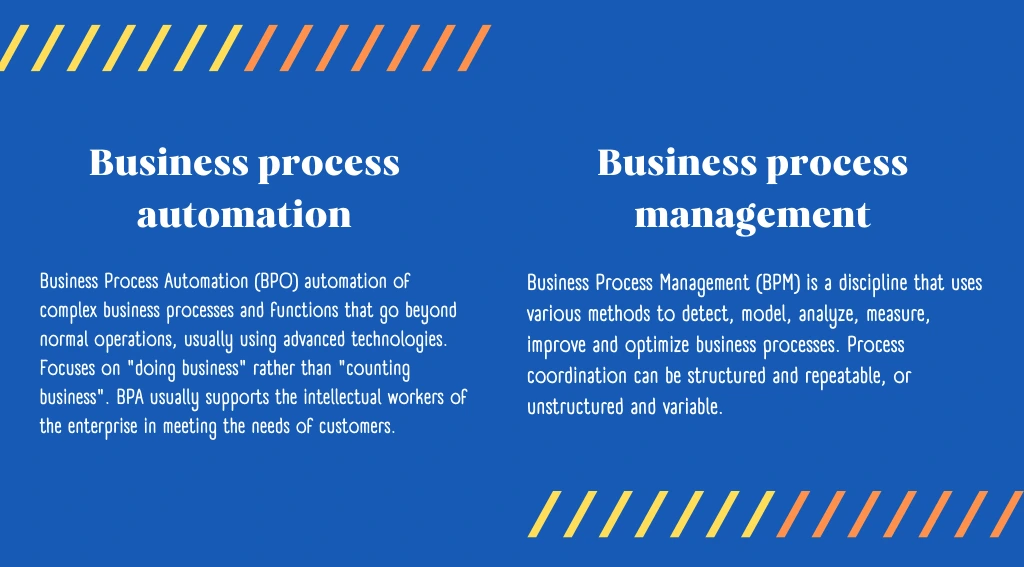Distinguishing between BPA and BPM (Business process automation and Business Process Management)


Technology and science are constantly evolving, making it possible to easily accelerate many familiar processes. Currently, automated technologies are being introduced everywhere. They are used in all areas of industry and production. It is a possibility to simplify the technological process and the work of the enterprise as a whole.
Automation of control systems implies a complex of software and hardware measures and tools. They allow modern methods to be actively implemented in all spheres. As a rule, Business Process Management and Business Process Automation are complementary concepts. But, they are not interchangeable terms. It is important to know the base differences between them and their characteristics. Today, the IT market continues to develop, introducing reliable and innovative BPM and BPA tools. This contributes to the rapid optimization of business processes.
BPA (Business Process Automation) is a rapidly developing technology that helps with the daily work routine of employees more efficiently. BPA systems are selected individually for each business. Specialists analyze daily business processes, identifying suitable methods for restructuring and full efficiency. The main task of the system is to systematize and unify each business process. For example, placing an order, sending an order, dialing a customer, collecting feedback, and so on.
Examples of BPA in various business areas:
BPA software can be used in almost any department. Including the HR department, supply chain, and IT. Form creation software is widely available. Business processes that are amenable to automation are triggered by a specific initiating event. For example, submitting an expense report may initiate a predefined sequence of steps. Sometimes BPA software is aimed at one goal. For example, expense reporting, but maybe part of a larger BPM.
BPM (Business Process Management) is the concept of process management of an organization. It combines ideology and software for business process management. The BPM concept considers the entire work of a company as a set of many business processes. As a rule, the system should have answers to all questions about the company. The purpose of the system is to achieve maximum productivity and efficiency in daily activities. It is usually implemented as an organization-wide approach. It requires a constant search for new ways to simplify and further improve the business workflow.
By implementing the concept of process management, the company will have many individual goals that are related to its type of activity. As for the global goals that are achievable with successful implementation, the following can be distinguished:
BPM software is more comprehensive. It is designed to manage multiple workflows in an organization. BPM software enables businesses to achieve greater overall efficiency and effectiveness. Another result of the successful implementation of BPM software is a reduction in the number of errors. Management by this method allows you to constantly analyze and improve the process itself based on real indicators.

To distinguish between BPM and BPA, we should say that BPA is part of BPM. While business process management is a management discipline that covers end-to-end process management at all stages, BPA focuses on business process analysis. BPA systems are used at the stages of displaying and modeling processes by analyzing and detailing information.
BPA and BPM as a single system? A company that wants to improve the efficiency of process management is implementing a BPMS system. BPMS (Business Process Management Suite) is a class of software. It helps to manage business processes in conditions of frequent changes. BPMS systems occupy their niche, not replacing, but complementing, the capabilities of existing systems and application software. This system can cover all BPA requirements by performing other stages of the process in BPM (such as implementation, monitoring, control, and refinement).
The impact that BPM and BPA methods can have on each situation is unique. At a superficial level, BPA may seem less effective because it is less complex. However, this is not always the case. You can significantly improve the result by automating the basic operation.
Do BPM and BPA systems interact? To get the most out of them, they must be combined together. Most companies view BPA tools as a simple solution. On the other hand, simply adding business process management (BPM) to an organization is a comprehensive approach. Because it focuses on optimization. By integrating BPM and BPA into the organization’s workflow, you can expect to get effective results. The implementation of any BPM and BPA in combination should be a priority for each organization.